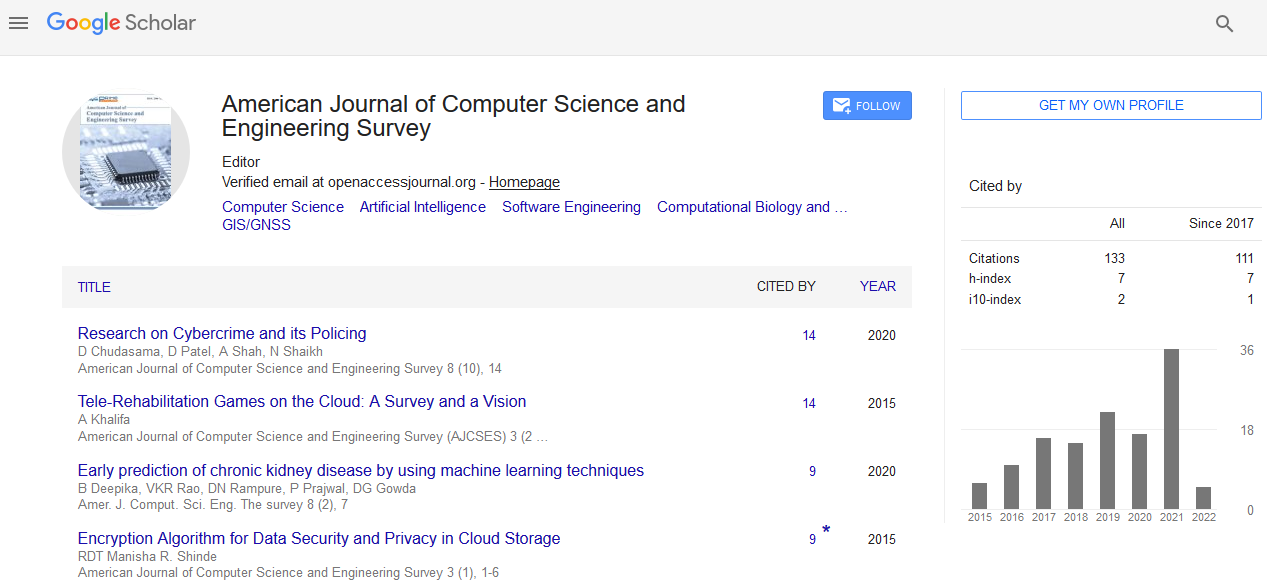Opinion - (2022) Volume 10, Issue 1
Analysis of Blockchain Technology
Zhijie Sun*
Department of Electronic and Electrical Communication, Shanghai Maritime University, China
*Correspondence:
Zhijie Sun, Department of Electronic and Electrical Communication, Shanghai Maritime University,
China,
Email:
Received: 03-Jan-2022, Manuscript No. IPACSES -22-12566;
Editor assigned: 05-Jan-2022, Pre QC No. IPACSES -22-12566(PQ);
Reviewed: 19-Jan-2022, QC No. IPACSES -22-12566;
Revised: 24-Jan-2022, Manuscript No. IPACSES -22-12566(R);
Published:
31-Jan-2022, DOI: 10.36846/IPAJCSES-10.1.5
Introduction
Clinical information includes a lot of individual data and is profoundly
security delicate. In the time of large information, the
expanding informatization of medical services makes it fundamental
that clinical data is put away safely and precisely.
Notwithstanding, current clinical data is dependent upon the
gamble of protection spillage and challenging to share. To resolve
these issues, this paper proposes a medical services data
security capacity arrangement in view of Hyperledger Fabric
and the Attribute Based Access Control (ABAC) structure. The
plan initially uses attribute based access control, which permits
dynamic and fine-grained admittance to clinical data, and afterward
stores the clinical data in the block chain, which can be
gotten and sealed by forming comparing shrewd agreements.
Additionally, this arrangement incorporates IPFS innovation to
assuage the strain of block chain stockpiling. Tests show that
the proposed conspire that joins property access control and
block chain innovation in this article cannot just guarantee
safe capacity and uprightness of clinical data, yet in addition
throughput high while getting to wellbeing data.
Description
The improvement of innovation, different arising advances
converging with the medical care industry make the most common
way of building medical services data innovation increasingly
perplexing. The World Health Organization characterizes
wellbeing data as the most innovative and shareable resource.
Today, the quantity of clinical offices on the planet shows development
by the file, and the clinical information produced by
clinical offices likewise shows unstable development. Because
of the expanding profundity of emergency clinic data, the data
framework in the clinic is bit by bit growing from a solitary SIS
charging framework to an electronic clinical record framework.
Clinical information goes with enlistment, finding and hospitalization, clinical information continuously becomes mind
boggling and stereoscopic, and the significance of protection
and security is expanded altogether. Nonetheless, since generally
clinical and medical services associations are disconnected
from one another, they store and hold clinical wellbeing information,
shaping information islands. In addition to the fact that
it is not helpful for the drawn out recording of patients with
the improvement of their infection, yet it additionally prompts
squandered clinical gear and an enormous number of copy
clinical information sources. To amplify the worth of clinical
wellbeing information, meet the essential requirements of
building clinical data, and give more adapted and smoothed
out administrations to patients, divide information among
clinical offices is an inescapable pattern. Moreover, because of
the inescapable utilization of arising Internet innovation in the
clinical field, the strategies and channels of clinical information
transmission are turning out to be progressively different and
steadily changing from intra-emergency clinic to intra-medical
clinic transmission. Clinical assessment, treatment and protection
furthermore different associations, and among patients
and clinical organizations, this likewise altogether builds the
trouble of safeguarding patient information.
Conclusion
The above reasons lead to the enormous scope, complex design
and fast improvement of clinical information, so tracking
down an optimal technique for putting away clinical data is undeniably
challenging. Luckily, lately, the ascent of block chain
innovation has brought new answers for the solid stockpiling
of clinical data. Fundamentally, block chain is a circulated data
set with the qualities of decentralization, security and straightforwardness.
As a decentralized information base, block chain
gives a solid answer for the issues of unfortunate sharing, low
productivity, and low security in clinical information the executives.
Information can be recorded on a common block chain stage progressively, and timestamps are added to guarantee
information changelessness. The immunity of the block chain
guarantees the security of clinical information. On the authorized block chain, block chain individuals can get data about information
through access activities.
Copyright: This is an open access article distributed under the terms of the Creative Commons Attribution License, which permits unrestricted use, distribution, and reproduction in any medium, provided the original work is properly cited.

